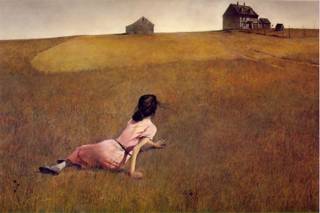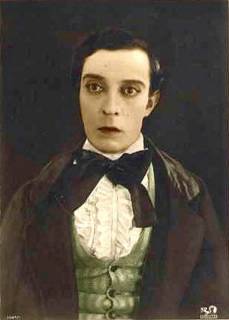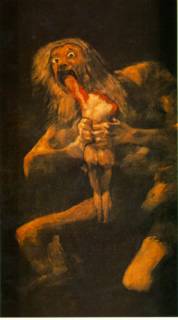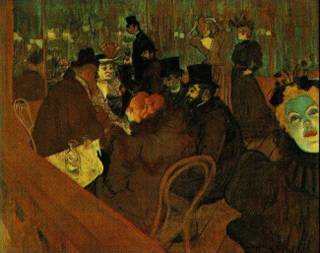Tuesday, December 28, 2004
#8: Christina's World
"It was the year, too, of Christina's World, a haunting portrait by Andrew Wyeth of a crippled woman and a forsaken house on a bleak New England hill…that would become one of the most popular paintings ever done by an American." David McCullough
This painting first came to my attention when I took the MCM 155 class. At first glance, the painting simply pictures a woman lying on the grass staring at a house at the distance. But in fact, it is much deeper than mere appearances. In http://www.ott.zynet.co.uk/polio/lincolnshire/library/drhenry/
christinasworld.html, I found an article in which "Dr. Henry Writes about 'Christina's World' " The woman is disabled and crawling across the fields, trying to get back to her house. Andrew Wyeth's famous painting easily tugs on the heart of the viewers. It is also mysterious as it evokes all kinds of questions, as Dr. Henry says,
"What inspired Wyeth to paint this image of a disabled woman?
Was Christina posing for this painting or was she doing something ordinary for her?
Did Christina have polio? If she had polio and cannot walk, where are her braces,
crutches or even her wheelchair?
Why is she alone in this state of helplessness?
Is she frightened, scared, crying, screaming for help or just determined?
Is she a young woman or even middle aged? Is she even a real person or just an artist's
creation?"
The woman was in fact a real person by the name of Christina Olsen. During 1916, there was a great polio epidemic that left victims paralyzed. Therefore, it is assumed that Christina had polio. Since she was a child, she had a limp that grew more serious as the years went by. By the age of 53, she became accustomed to crawling from place to place as she refused to use a wheelchair. When Wyeth and his wife moved next door to her, Wyeth often saw the woman crawling to her parent's graves and was intrigued by her. He sketched her for his painting "Christina's World," which soon gained worldwide recognition.
After her death, it was realized that her condition was mostly likely a degenerative disorder-although polio may have been a possibility.
It is interesting how Wyeth used this painting to sum up Christinia's life. I see it as a visual autobiography. This is one of the functions of art- to record information about people's lives. Christinia's story is a unique one, full of drama, heartache, optimism and tragedy. We have seen how artists have attempted to show the world something never done before. Wyeth has simply done that with his portrayal of the crippled Christina in this chilling manner. The painting encompasses all emotions- determination... optimism... helplessness... vulnerability... strength... hope. The result is a masterpiece that will remain in our minds and heart forever.
But what is Christina feeling at the moment portrayed in the painting? Dr. Henry makes an interesting response:
"In my mind, if I could call out to Christina in the painting, I imagine her turning her head and responding with a smile."
This painting first came to my attention when I took the MCM 155 class. At first glance, the painting simply pictures a woman lying on the grass staring at a house at the distance. But in fact, it is much deeper than mere appearances. In http://www.ott.zynet.co.uk/polio/lincolnshire/library/drhenry/
christinasworld.html, I found an article in which "Dr. Henry Writes about 'Christina's World' " The woman is disabled and crawling across the fields, trying to get back to her house. Andrew Wyeth's famous painting easily tugs on the heart of the viewers. It is also mysterious as it evokes all kinds of questions, as Dr. Henry says,
"What inspired Wyeth to paint this image of a disabled woman?
Was Christina posing for this painting or was she doing something ordinary for her?
Did Christina have polio? If she had polio and cannot walk, where are her braces,
crutches or even her wheelchair?
Why is she alone in this state of helplessness?
Is she frightened, scared, crying, screaming for help or just determined?
Is she a young woman or even middle aged? Is she even a real person or just an artist's
creation?"
The woman was in fact a real person by the name of Christina Olsen. During 1916, there was a great polio epidemic that left victims paralyzed. Therefore, it is assumed that Christina had polio. Since she was a child, she had a limp that grew more serious as the years went by. By the age of 53, she became accustomed to crawling from place to place as she refused to use a wheelchair. When Wyeth and his wife moved next door to her, Wyeth often saw the woman crawling to her parent's graves and was intrigued by her. He sketched her for his painting "Christina's World," which soon gained worldwide recognition.
After her death, it was realized that her condition was mostly likely a degenerative disorder-although polio may have been a possibility.
It is interesting how Wyeth used this painting to sum up Christinia's life. I see it as a visual autobiography. This is one of the functions of art- to record information about people's lives. Christinia's story is a unique one, full of drama, heartache, optimism and tragedy. We have seen how artists have attempted to show the world something never done before. Wyeth has simply done that with his portrayal of the crippled Christina in this chilling manner. The painting encompasses all emotions- determination... optimism... helplessness... vulnerability... strength... hope. The result is a masterpiece that will remain in our minds and heart forever.
But what is Christina feeling at the moment portrayed in the painting? Dr. Henry makes an interesting response:
"In my mind, if I could call out to Christina in the painting, I imagine her turning her head and responding with a smile."
Friday, December 24, 2004
#7: The Great Stone Face
"In a way his pictures are like a transcendent juggling act in which it seems that the whole universe is in exquisite flying motion and the one point of repose is the juggler's effortless, uninterested face."
-- James Agee, "Comedy's Greatest Era"
The man who wouldn’t lie down. The great stone face. A silent film legend. So many descriptions exist for the one and only Buster Keaton.
In http://www.cinepad.com/busterk.htm, I found a website with the article "The Beauty of Buster" dedicated to the famous comedy star. Buster Keaton was a genius in the silent film world of the 1900's. Too often, however, his brilliance is overshadowed by other legendary greats like Charlie Chaplin( the creator of the little tramp) and Harold Lloyd ( the creator of the daredevil comedy).
According to Fang, the new movie goers of the silent film age sought movies for their escape. They entered the theatre to enter a fantasy world where they can forget their problems. They wanted to laugh and the slapstick comedies in particular provided that opportunity. Fang explains slapstick comedies where danger pervailed and "hairbreadth escapes were common... settings were realistic, but the realism was exaggerated to absurdity by fast motion film, ridiculous props, split-second timing, and incongruous film cutting."
But Keaton provided audiences with a unique chain of movies, that is widely appreciated even today. I never ever thought I could be a fan of silent comedy films. In fact, I found black and white silent films very creepy. Also, I never understood why people would want to watch old ingenuous movies when new and sophisticated films with enormous sound and quality pictures were dropping in theatres everyday. But after taking MCM 155, I began to become fascinated with how directors and actors were able to create such advanced and cutting edge films integrating a host of dangerous stunts and hilarious scenes. All without the technology of today! All without any sound! It is quite remarkable indeed.
In particular, Keaton was an actor and director brimming with talent. With his trademark "uninterested face" as Agee calls it, Keaton was able to express emotion with an expressionless visage. It may be confusing and difficult to believe, but watch one of his movies and you will fully understand the idea. His face exhibited the despair of the "punches the universe threw at him" and then the joy "of being alive in this whirlwind of a universe." Keaton provided his audience with such an interesting idea indeed, always embodying characters who fight to survive whatever the world cast at him until he is victorious at the end.
The author Jim Emerson wrote that in his films, Keaton simply trusted the universe, against a number of lifethreatening situations. For example, in Steamboat Bill Jr, he survives a hurricane; in Seven Chances, he runs from an avalanche; in The General, he wins in a Civil War battle; in Our Hospitality, he fights a violent river. In each film, Keaton cleverly tries to teach audiences that with the right skills, they can approach ugly circumstances and survive triumphantly. Through his silent comedy, the mastermind tried to evoke sentiment (as well as laughs) from his audience so they can relate the character's absurd situation to their own lives. Finally, he wanted audiences to come out of the theatre feeling refreshed and optimistic after watching one of his heartwarming comedies.
He tended to incorporate romance in his movies as well. In addition to overcoming the life threatening task at hand, he needed to reach a goal- the goal of proving himself to his love interest. But the little guy seems to always triumph and win the happily ever after fantasy with his love.
Not only were viewers satisfied with the invigorating experience of watching a Buster Keaton film, they were fascinated by the remarkable and dangerous stunts he performed. Back then, neither technological devices nor computer graphics existed that help to add the superficial danger to today's film plots. Keaton did not use such convenient technology nor a stunt double to create his dangerous slapstick comedies. For example, in Steamboat Bill Jr, a wall crashes down just missing Buster's head by an inch. Despite knowing the dangers of performing such a stunt, he followed through to create one of the most dangerous filmed acts.
Silent films were never silent. Keaton's films were an experience.
-- James Agee, "Comedy's Greatest Era"
The man who wouldn’t lie down. The great stone face. A silent film legend. So many descriptions exist for the one and only Buster Keaton.
In http://www.cinepad.com/busterk.htm, I found a website with the article "The Beauty of Buster" dedicated to the famous comedy star. Buster Keaton was a genius in the silent film world of the 1900's. Too often, however, his brilliance is overshadowed by other legendary greats like Charlie Chaplin( the creator of the little tramp) and Harold Lloyd ( the creator of the daredevil comedy).
According to Fang, the new movie goers of the silent film age sought movies for their escape. They entered the theatre to enter a fantasy world where they can forget their problems. They wanted to laugh and the slapstick comedies in particular provided that opportunity. Fang explains slapstick comedies where danger pervailed and "hairbreadth escapes were common... settings were realistic, but the realism was exaggerated to absurdity by fast motion film, ridiculous props, split-second timing, and incongruous film cutting."
But Keaton provided audiences with a unique chain of movies, that is widely appreciated even today. I never ever thought I could be a fan of silent comedy films. In fact, I found black and white silent films very creepy. Also, I never understood why people would want to watch old ingenuous movies when new and sophisticated films with enormous sound and quality pictures were dropping in theatres everyday. But after taking MCM 155, I began to become fascinated with how directors and actors were able to create such advanced and cutting edge films integrating a host of dangerous stunts and hilarious scenes. All without the technology of today! All without any sound! It is quite remarkable indeed.
In particular, Keaton was an actor and director brimming with talent. With his trademark "uninterested face" as Agee calls it, Keaton was able to express emotion with an expressionless visage. It may be confusing and difficult to believe, but watch one of his movies and you will fully understand the idea. His face exhibited the despair of the "punches the universe threw at him" and then the joy "of being alive in this whirlwind of a universe." Keaton provided his audience with such an interesting idea indeed, always embodying characters who fight to survive whatever the world cast at him until he is victorious at the end.
The author Jim Emerson wrote that in his films, Keaton simply trusted the universe, against a number of lifethreatening situations. For example, in Steamboat Bill Jr, he survives a hurricane; in Seven Chances, he runs from an avalanche; in The General, he wins in a Civil War battle; in Our Hospitality, he fights a violent river. In each film, Keaton cleverly tries to teach audiences that with the right skills, they can approach ugly circumstances and survive triumphantly. Through his silent comedy, the mastermind tried to evoke sentiment (as well as laughs) from his audience so they can relate the character's absurd situation to their own lives. Finally, he wanted audiences to come out of the theatre feeling refreshed and optimistic after watching one of his heartwarming comedies.
He tended to incorporate romance in his movies as well. In addition to overcoming the life threatening task at hand, he needed to reach a goal- the goal of proving himself to his love interest. But the little guy seems to always triumph and win the happily ever after fantasy with his love.
Not only were viewers satisfied with the invigorating experience of watching a Buster Keaton film, they were fascinated by the remarkable and dangerous stunts he performed. Back then, neither technological devices nor computer graphics existed that help to add the superficial danger to today's film plots. Keaton did not use such convenient technology nor a stunt double to create his dangerous slapstick comedies. For example, in Steamboat Bill Jr, a wall crashes down just missing Buster's head by an inch. Despite knowing the dangers of performing such a stunt, he followed through to create one of the most dangerous filmed acts.
Silent films were never silent. Keaton's films were an experience.
Tuesday, December 07, 2004
#6: The First of the Moderns
Francisco Goya is the Spanish painter famous for his gory and realistic war scenes. According to http://www.ibiblio.org/wm/paint/auth/goya/ 's "Goya y Lucientes, Francisco José de," although he was the royal court painter, his famous works were NOT his royal paintings. Instead, violent and horrific scenes from the famous Napoleonic invasion of Spain was depicted. An example, is the painting we viewed in class entitled "The Disasters of War" or "Los desastres de la guerra." It was an etching depicting the atrocities of the French occupation of Spain. It highlighted the dark side of human nature when the French mercilessly shot men, women, and children. In his painting, Goya sought to show the impact of modern technology realistically, instead of the traditional romantic idealization. Such paintings shocked 19th century audiences for their portrayal of bold and haunting realism.
It is interesting to learn about how life drove him to painting the famous war paintings. He was born in 1746 in Fuendetodos, Spain. He first became reputable for his artistic abilities in the frescoes he painted for the local cathedral. He painted in the rococo tradition which came to France, after the Baroque Art. After some research pertaining to this art style, I can conclude that it is a light, elaborate and decorative art, according to www.artcyclopedia.com/history/rococo.html article entitled "Artists by Movement: Rococo Art."
He developed his art when he became a tapestry designer and painted his first GENRE paintings. In class, we learned genre paintings are realistically depicted scenes from everyday life.
He changed his art style after he became permanantly deaf from a severe illness. He began to critically study and observe humankind. In fact, he established CAPRICHOS, a book of etchings illustrating the results of these observations. I wanted to explore the contents of "Caprichos" and found http://goya.unizar.es/InfoGoya/Work/Caprichos.html which displays the 80 painting collection. In general, the etches mock the absurdities and weakenesses of human beings. She leaves him penniless, Sleep overcomes them, Squealers, Pretty teacher are only a few titles from the collection which is worth looking into.
He served as the Spanish court painter and later during the Napoleonic invasion, as the French court painter. But none of his war paintings were published until after his death.
With the independence of Spain from France, Goya left the French court. However, his paintings were not appreciated in Spain. For "The Naked Maja," he needed to explain his integration of a nude- an unacceptable element in art at the time. He was not the first and only painter who faced opposition from society for painting naked individuals. "Luncheon on the Grass," a work by Eduoard Manet featured a naked woman, which was presented in class, was viewed as unconventional as well as vulgar.
The Black Paintings, were a series of paintings illustrated on the walls of Goya's walls that were very dark and disturbing. An example of such a painting is found at the bottom of the website, where a small collection of Goya's famous paintings are situated. "Saturn Devouring his Son" shows an angry and ghastly creature eating a bleeding and naked baby whose head and arm are already gone. This painting is most disturbing indeed and shows us a glimpse into Goya's dark visions. Goya is retelling the story of the god, Saturn, who was forced to eat all his children after he learned that one of them will kill him. These paintings that depict his darkest visions, give the viewer a unique experience. They portray unconventional, uncomfortable and sinister images that exposes the viewer to something new and something strange. In my opinion, they contribute to Goya's entire artistic oeuvre. Such paintings offer audiences a glimpse into the author's sorrowful and twisted mental state. Audiences are transported into the author's world where they have the opportunity to experience this dark mental state.
The other paintings shown below feature royalty during which were created when Goya was a royal painter. Others portray historical events of war events, like "The Shootings of May Third," painted in direct realism.
It is interesting to learn about how life drove him to painting the famous war paintings. He was born in 1746 in Fuendetodos, Spain. He first became reputable for his artistic abilities in the frescoes he painted for the local cathedral. He painted in the rococo tradition which came to France, after the Baroque Art. After some research pertaining to this art style, I can conclude that it is a light, elaborate and decorative art, according to www.artcyclopedia.com/history/rococo.html article entitled "Artists by Movement: Rococo Art."
He developed his art when he became a tapestry designer and painted his first GENRE paintings. In class, we learned genre paintings are realistically depicted scenes from everyday life.
He changed his art style after he became permanantly deaf from a severe illness. He began to critically study and observe humankind. In fact, he established CAPRICHOS, a book of etchings illustrating the results of these observations. I wanted to explore the contents of "Caprichos" and found http://goya.unizar.es/InfoGoya/Work/Caprichos.html which displays the 80 painting collection. In general, the etches mock the absurdities and weakenesses of human beings. She leaves him penniless, Sleep overcomes them, Squealers, Pretty teacher are only a few titles from the collection which is worth looking into.
He served as the Spanish court painter and later during the Napoleonic invasion, as the French court painter. But none of his war paintings were published until after his death.
With the independence of Spain from France, Goya left the French court. However, his paintings were not appreciated in Spain. For "The Naked Maja," he needed to explain his integration of a nude- an unacceptable element in art at the time. He was not the first and only painter who faced opposition from society for painting naked individuals. "Luncheon on the Grass," a work by Eduoard Manet featured a naked woman, which was presented in class, was viewed as unconventional as well as vulgar.
The Black Paintings, were a series of paintings illustrated on the walls of Goya's walls that were very dark and disturbing. An example of such a painting is found at the bottom of the website, where a small collection of Goya's famous paintings are situated. "Saturn Devouring his Son" shows an angry and ghastly creature eating a bleeding and naked baby whose head and arm are already gone. This painting is most disturbing indeed and shows us a glimpse into Goya's dark visions. Goya is retelling the story of the god, Saturn, who was forced to eat all his children after he learned that one of them will kill him. These paintings that depict his darkest visions, give the viewer a unique experience. They portray unconventional, uncomfortable and sinister images that exposes the viewer to something new and something strange. In my opinion, they contribute to Goya's entire artistic oeuvre. Such paintings offer audiences a glimpse into the author's sorrowful and twisted mental state. Audiences are transported into the author's world where they have the opportunity to experience this dark mental state.
The other paintings shown below feature royalty during which were created when Goya was a royal painter. Others portray historical events of war events, like "The Shootings of May Third," painted in direct realism.
Wednesday, December 01, 2004
#5: The Avant Garde Lautrec
On my pursuit to learn more about a particularly interesting artist of the avant garde period, I found an article entitled "Toulouse Lautrec Biography 1864-1901" about the French Impressionist on http://www.artelino.com/articles/toulouse_lautrec.asp. As I read the article, I found my prior knowledge from the MCM 102 class helpful in fully realizing and appreciating Lautrec's life and works.
He was born into an aristocratic family but never participated in aristrocratic activities due to a disability that inhibited the normal development of his legs. Thus, he delved into his own world of painting. He did not appreciate the conventional art of Van Gogh but the more Impressionist art of Degas. Impressionism could be defined as art whose role is to present a subjective impression rather than an objective reality. For the subject of his art, Lautrec would portray the essence of Parisien nightlife and sketch scenes of the caberets, dance halls, brothels, etc.
His paintings gained instant recognition and popularity among the French because he presented a behind the scenes look into the nightlife of Paris. I was eager to explore more about the content of his paintings so I explored the books found in the university library. I found a sufficient collection in the book "Toulouse-Lautrec : A Retrospective," edited by Gale B. Murray. Many of his paintings consisted of partially or wholly naked women in the process of dressing, dancing, lounging, washing, among other things. They are not posing stiffly as women often did in traditional and classical paintings. Instead, Lautrec captured them in the midst of normal and unrestrained behavior. I believe that this new veracity added to the intrigue of the paintings. Lautrec was truly an avant-garde artist who, according to Pelfrey, "broke with the perspective tradition and began to create new artistic languages that ultimately opened up new views of reality as well as new forms of art."
Interestingly, the influence of Lautrec's art was the Japanese woodblock prints. According to the article, Lautrec's use of perspective as well as flat color was inspired from those prints. Even the idea of representing the night world was derived from observing his collection of Japanese prints.
The avant garde artists were not all welcomed into society. As discussed in class, during the mid 1800's, Gustave Corbet's brutally real paintings were rejected in salons and Edouard Manet's paintings were vehemently regarded as vulgar. However, Lautrec painted during the last few years of the 19th century, when the people had already become exposed to such new art and were more accepting and actually excited about the avant garde movement.
He was born into an aristocratic family but never participated in aristrocratic activities due to a disability that inhibited the normal development of his legs. Thus, he delved into his own world of painting. He did not appreciate the conventional art of Van Gogh but the more Impressionist art of Degas. Impressionism could be defined as art whose role is to present a subjective impression rather than an objective reality. For the subject of his art, Lautrec would portray the essence of Parisien nightlife and sketch scenes of the caberets, dance halls, brothels, etc.
His paintings gained instant recognition and popularity among the French because he presented a behind the scenes look into the nightlife of Paris. I was eager to explore more about the content of his paintings so I explored the books found in the university library. I found a sufficient collection in the book "Toulouse-Lautrec : A Retrospective," edited by Gale B. Murray. Many of his paintings consisted of partially or wholly naked women in the process of dressing, dancing, lounging, washing, among other things. They are not posing stiffly as women often did in traditional and classical paintings. Instead, Lautrec captured them in the midst of normal and unrestrained behavior. I believe that this new veracity added to the intrigue of the paintings. Lautrec was truly an avant-garde artist who, according to Pelfrey, "broke with the perspective tradition and began to create new artistic languages that ultimately opened up new views of reality as well as new forms of art."
Interestingly, the influence of Lautrec's art was the Japanese woodblock prints. According to the article, Lautrec's use of perspective as well as flat color was inspired from those prints. Even the idea of representing the night world was derived from observing his collection of Japanese prints.
The avant garde artists were not all welcomed into society. As discussed in class, during the mid 1800's, Gustave Corbet's brutally real paintings were rejected in salons and Edouard Manet's paintings were vehemently regarded as vulgar. However, Lautrec painted during the last few years of the 19th century, when the people had already become exposed to such new art and were more accepting and actually excited about the avant garde movement.
Despite his popularity, Lautrec spun into whirlwind of alcoholism that deterioriated his health until 1901, when he died from a stroke. The legendary artist only lived 36 years but created art that will last till the end of time.






